Arts and crafts
Arts and crafts and utilitarian objects are valuable elements of our collections, complementing the history associated with money.
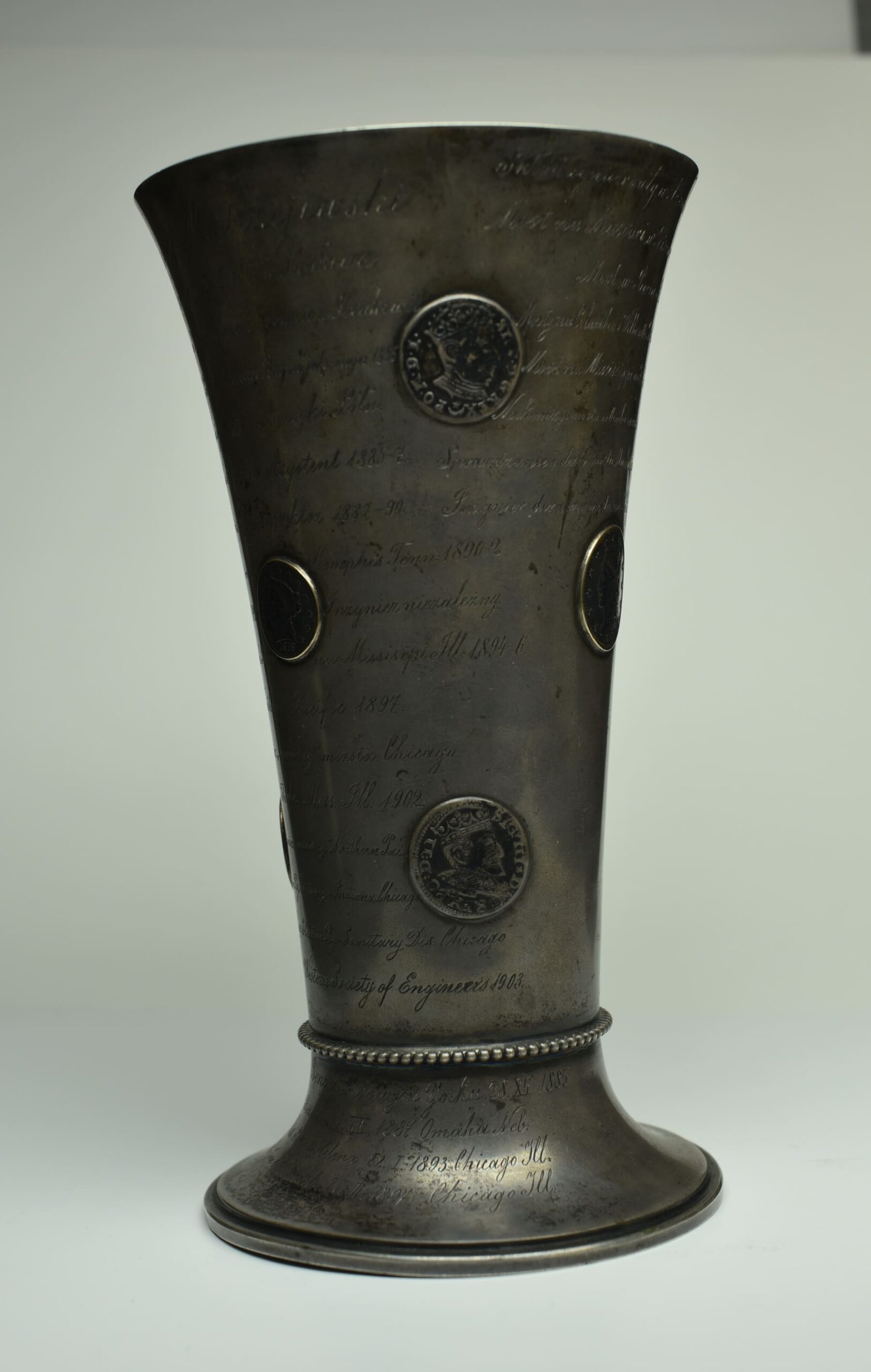
Mug dedicated to Rudolf Modrzejewski
A simple silver mug, covered with engraved inscriptions and decorated with ten coins. Although it is unattractive in form and does not attract attention like other vessels on the display, there is an interesting story behind it. The mug was dedicated and probably also offered to Rudolf Modrzejewski, the son of the famous Polish actress Helena Modrzejewska and Gustaw Zimajer. Modrzejewski was an outstanding railway engineer recognized in the USA and Europe and a pioneer in the construction of suspension bridges. The vessel has a simple form, slightly widening at the top, and is decorated with silver (5 pieces) and gold (4 pieces) coins on its body. The placement of coins of kings considered good rulers in Polish historiography, i.e. the last king of Poland and the city of Kraków, has definitely patriotic connotations. Using the US coins can be explained by the fact that this country became the second homeland to Modrzejewski, known in the USA as Ralph Modjeski, but the presence of the Russian coin is difficult to explain. All coins are installed with their obverse facing out, so that the busts can be seen, and the gold coins are silver-plated on their obverse, so that the entire vessel appears silver. The numerous engravings in Polish on the body and on the bottom of the mug refer to various aspects of Ralph Modjeski's (as he presented himself outside Poland for simplicity) private and professional life.
The exhibit is available in the room:
Antiquity – Middle Ages – Modernity
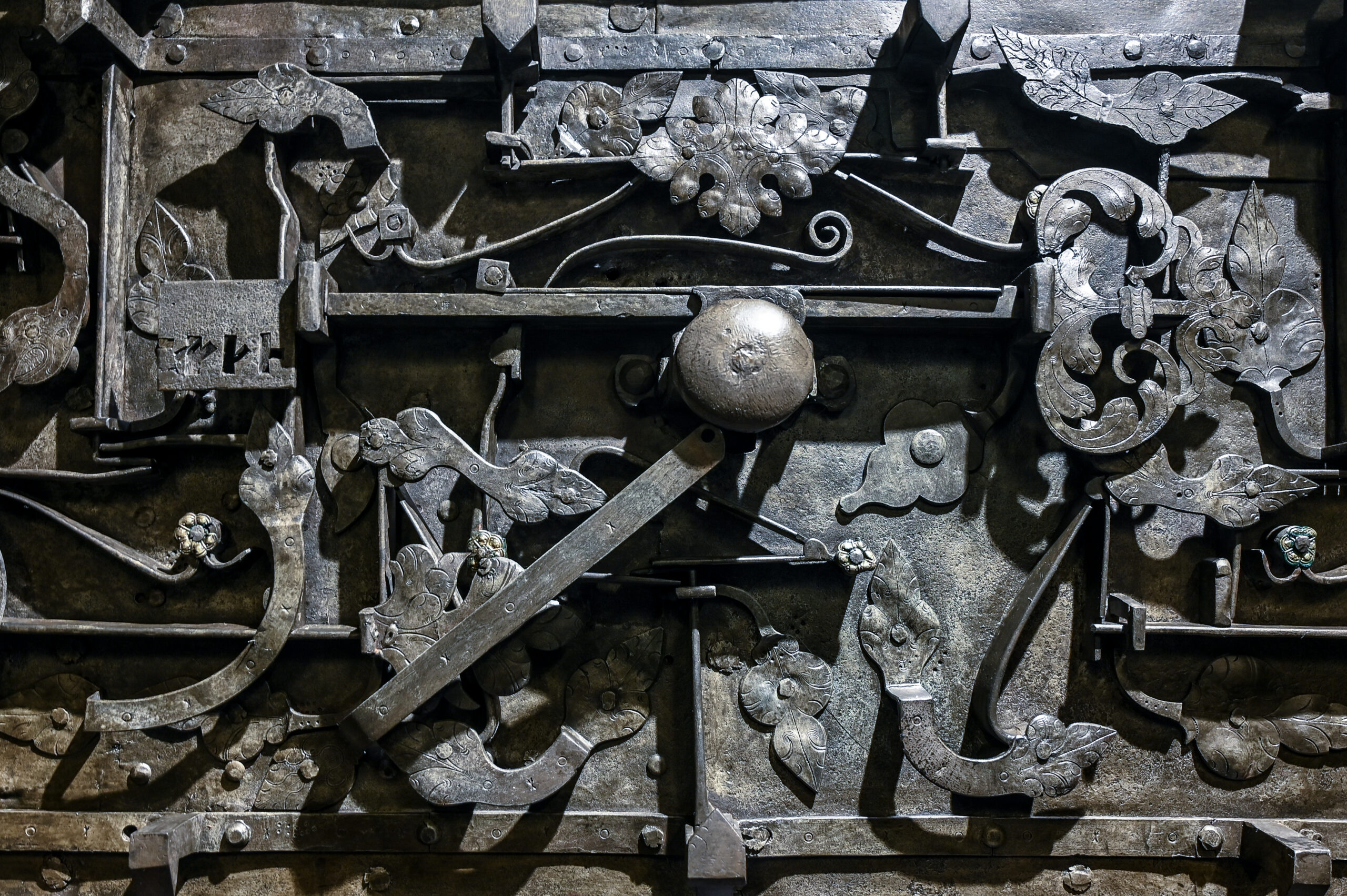
Treasury chest from the 18th century
The chest is a masterpiece of blacksmith art. The box weighing approximately 50 kilograms was made of steel plate and reinforced with iron rails. At the front there are two padlockable handles (fixed or movable metal handles placed on the chest, trunk, door or gate). A dummy lock was installed between them. What is most interesting, however, is its lid. Locked from the outside with a massive key, the lock hides a complex mechanism from the inside. Turning the key simultaneously activates eleven bolts that lock the lid around the entire circumference of the chest. The mechanism was decorated with plant motifs, and in the central part the craftsman
The exhibit is available in the room:
Vault
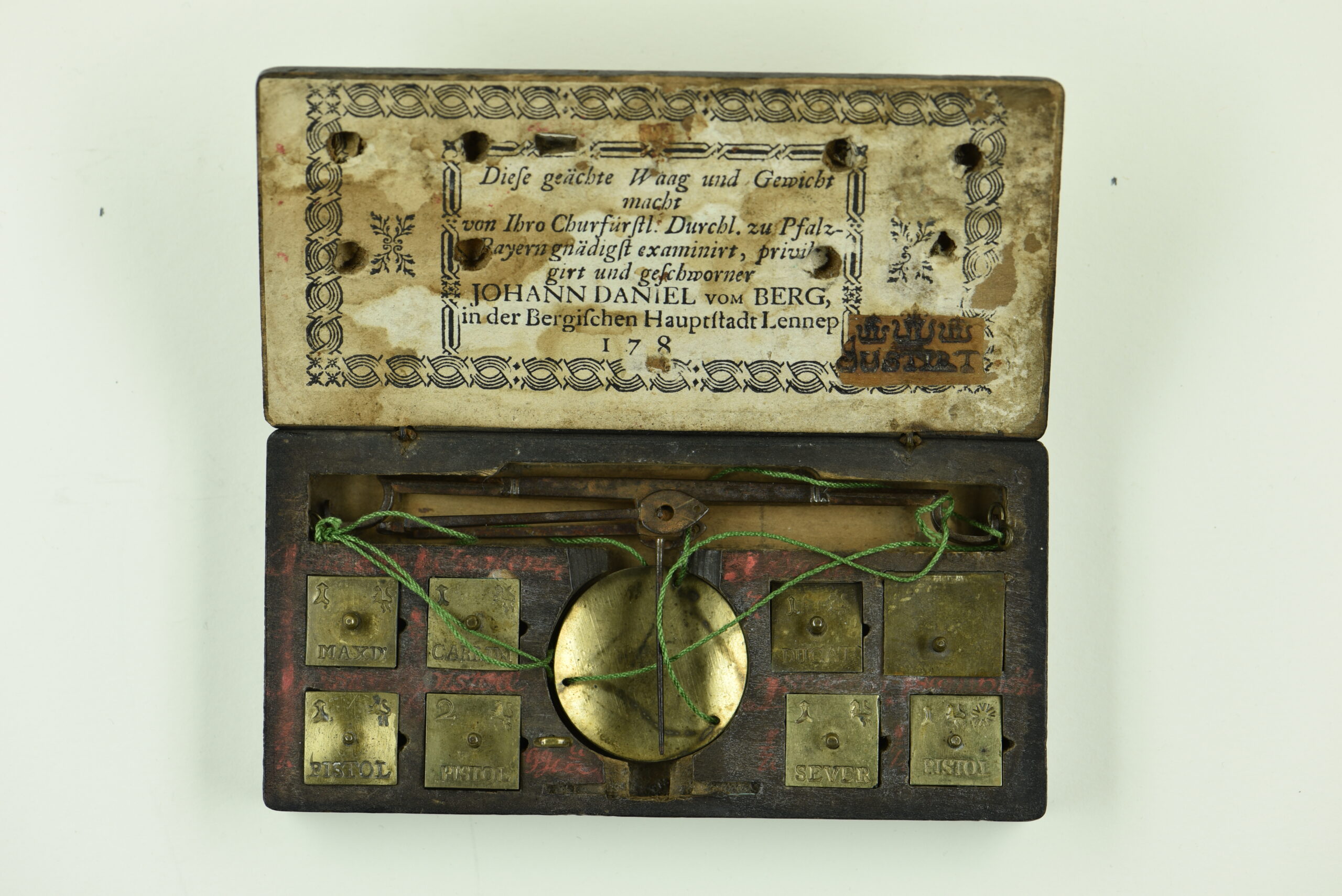
Beam balance scale
A jewelry scale with a set of weights for modern gold coins, dated back to the 1780s, comes from the famous workshop of Johann Daniel vom Berg, from the former city of Lennep (today a district of Remscheid near Düsseldorf), which at that time belonged to Bavaria-Pfalz. The steel beam balance scale has a shape typical for this period with goose-neck ends and two brass pans (scales) suspended on strings. Monetary weights, i.e. objects with a standard weight for a given type of coin, were used to check the correct weight of a coin. Seven brass weights in the shape of a truncated pyramid with a handle are located together with the scale in a wooden box. On each of them, apart from the name of the denomination, one can find an image of the heraldic lion of the former Duchy of Berg. There is also a label which was put on the inside of the lid with the manufacturer's name and a fragment of the date "178". This means that the scale was produced in the 1780s, between 1782, the year in which Johann Daniel vom Berg received his master's patent, and 1789. Scales of this type were very common in early modern Europe. The sets of weights attached to them could be expanded up to 20 pieces and intended for weighing various denominations from various mint systems, e.g. French louis, Austrian crowns or English guineas.
The exhibit is available in the room:
Antiquity – Middle Ages – Modernity
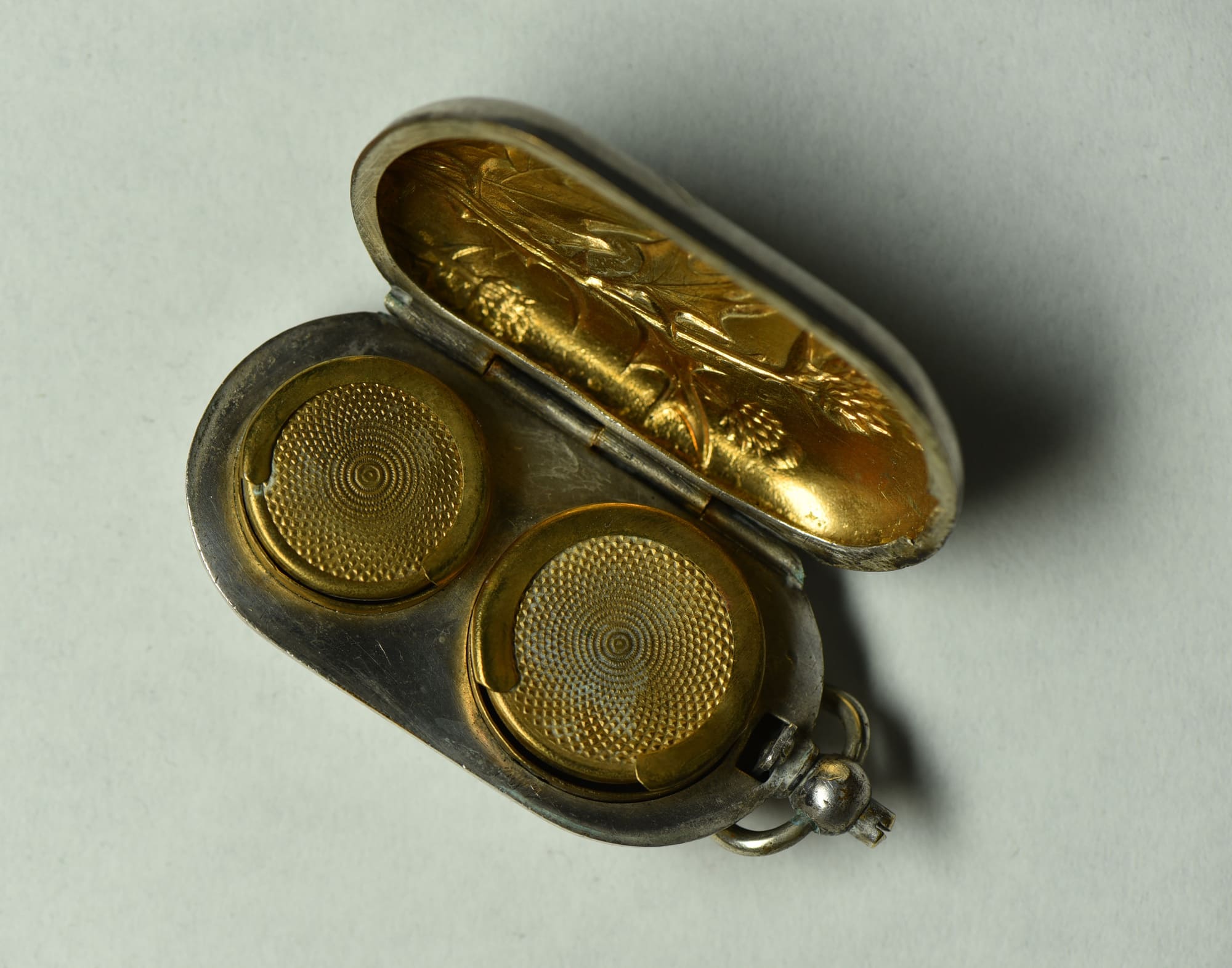
Decorative coin case
A case for storing two types of small coins, that can be inserted and withdrawn using a spring mechanism. The cover has an embossed and partially gilded plant motif (a thistle branch with a flower) in the Art Nouveau style. In this case, there is no information about the origin of the gadget, however it is believed that it was made in a northern European workshop around the turn of the 19th and 20th centuries.
The exhibit is available in the room:
Antiquity – Middle Ages – Modernity
Numismatic collections
Numismatic collections are collections of coins, banknotes and other objects related to money, representing a fascinating field of numismatics. They include a variety of historical and artistic objects, presenting the cultural and economic wealth of societies over time.
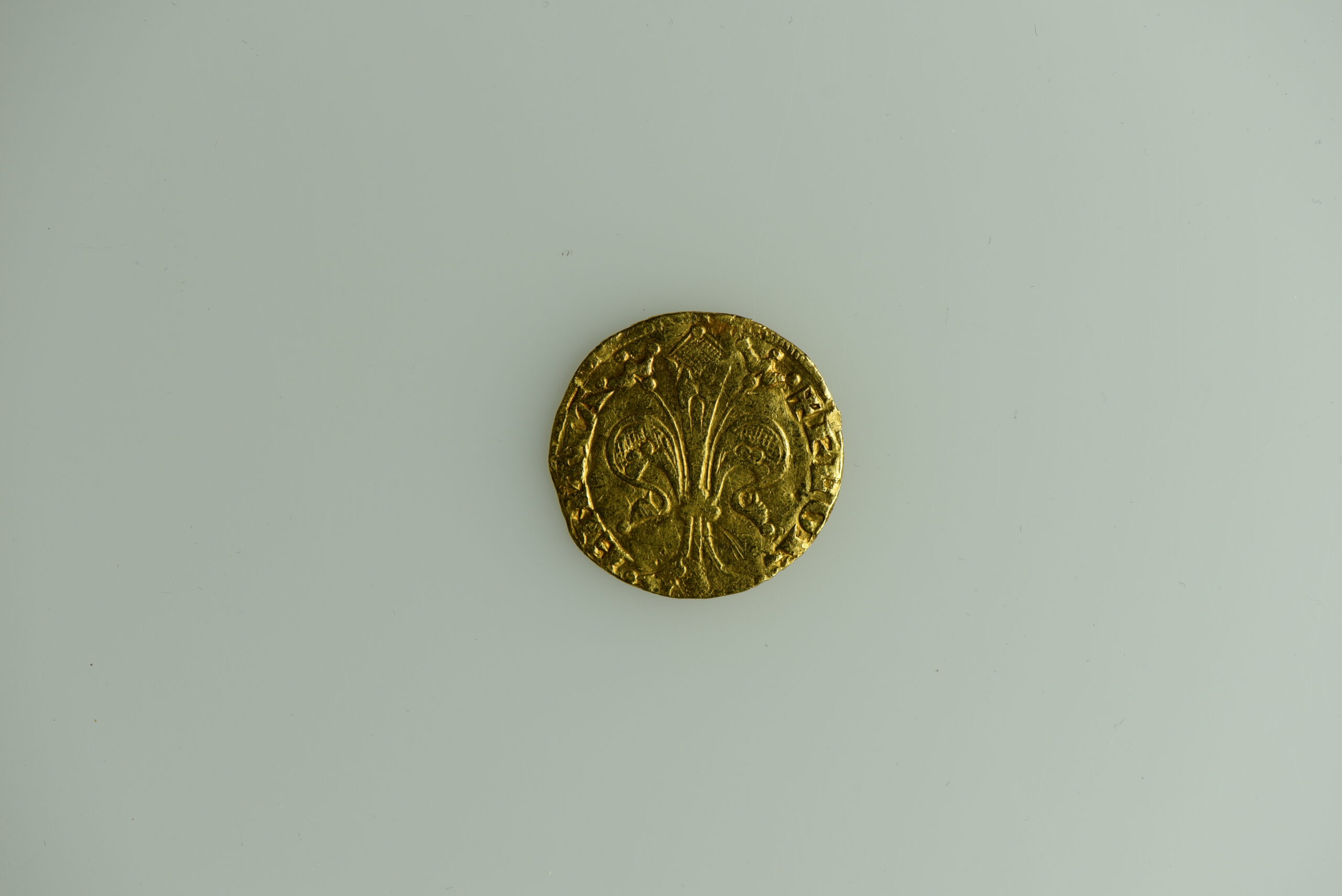
Florin
Florin (It: fiorini), minted in Florence in the 14th century, perhaps in 1308. Its name does not come from the name of the city, but from the image of a flower on the obverse. A flower in Latin is florus, in Italian it is fiore. From this comes the name of the city of Florence (Latin: Florentia, Italian: Firenze). The lily flower is also a distinctive emblem, understandable even to the illiterate. Why specifically the lily? In the Middle Ages, it had very complex symbolism also associated with the Marian cult. As one of Mary's attributes, it symbolized purity, innocence, but also greatness, glory, majesty and beauty. Mary was one of the city's patronesses, perhaps that is why the rulers of Florence chose this particular plant as their emblem, emphasizing both the divine protection of the city and its magnificence. The lily had already appeared on earlier silver groschen, so the florins repeated a well-known and established motif - a flower in profile, with three petals and two stamens between them, in a beautiful Gothic style, designed in the first half of the 13th century. The image of the reverse is not accidental either - Saint John the Baptist was highly respected in the Middle Ages, he was the patron of the Florence Cathedral, as well as one of the guardians of Florence. On the coin, he stands upright, dressed in a characteristic camel skin cloak, with long hair and beard, holding a scepter and a book (implicitly the Holy Bible) in his hands. This representation dominated the later iconography of the saint. The inscriptions on both sides of the coin confirm the above interpretations, both begin with the so-called initial crosses - on the obverse, the rim says: FLOR• - •ENTIA and on the reverse, the inscription is: •S•IOHA - NNES•B and it ends with the five-petal leaf mark.
The exhibit is available in the room:
Antiquity – Middle Ages – Modernity
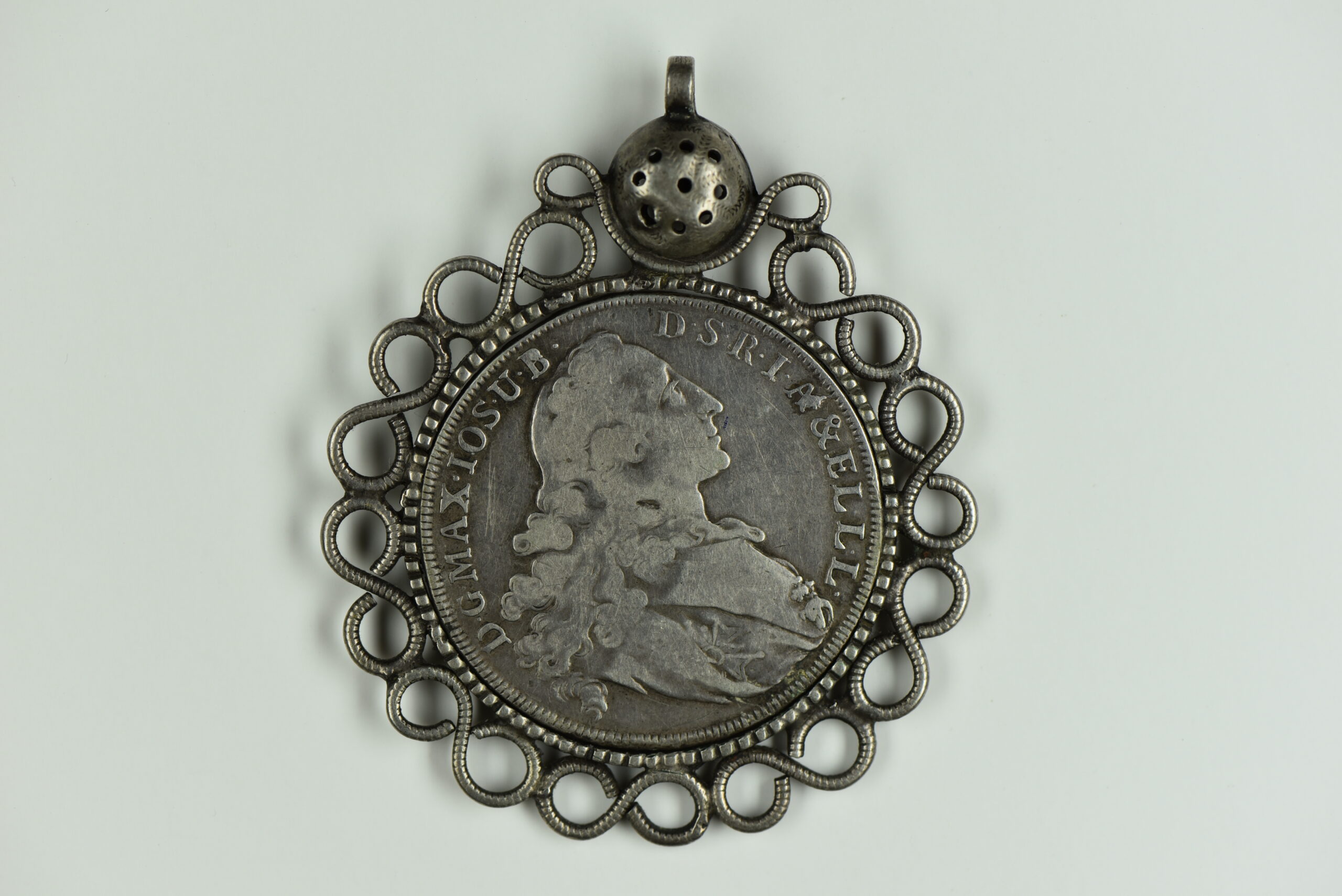
Pendant with a Bavarian thaler
A pendant with the so-called Madonnentaler from 1765, in a jewelry setting, belonging to the so-called numismatic jewelry. On the obverse of the thaler there is a draped bust of the Elector of Bavaria, Maximilian III Joseph, while the reverse shows the Virgin Mary with the Child, depicted in the type of Patrona Bavariae. Hence the name of this coin. The motif of the Virgin Mary and the Child appeared on coins already in the Middle Ages and since the times of Emperor Matthias Corvinus it became the leading motif of Hungarian coins, accompanied by the legend of PATRON HUNGARIAE. It survived in the established iconographic scheme until the end of Hungarian independence, and later also on money minted in the territory of the empire. It is less common in the minting of other countries, such as Bavaria, Austria, Italy or Silesia under Hungarian influence, and occasionally even on a coin of the Teutonic Order from the times of Albrecht Hohenzollern. The thaler’s setting consists of a simple frame made of pearl wire, topped with an openwork ball and a loop for hanging, covering the inscription IN DEO CONSILIUM on the edge. Some wear on the coin indicates that it was long used as money. It was set as a pendant at a later date, yet it is difficult to determine when, perhaps even in the 19th century - the frame is not as worn as the coin, the cuts on the wire are perfectly visible. Whether this type of ornament served as an expression of loyalty to the ruling house of the Bavarian Wittelsbachs or as a manifestation of religious commitment is difficult to determine. In this case, it could easily serve both functions or simply be original jewelry.
The exhibit is available in the room:
Antiquity – Middle Ages – Modernity
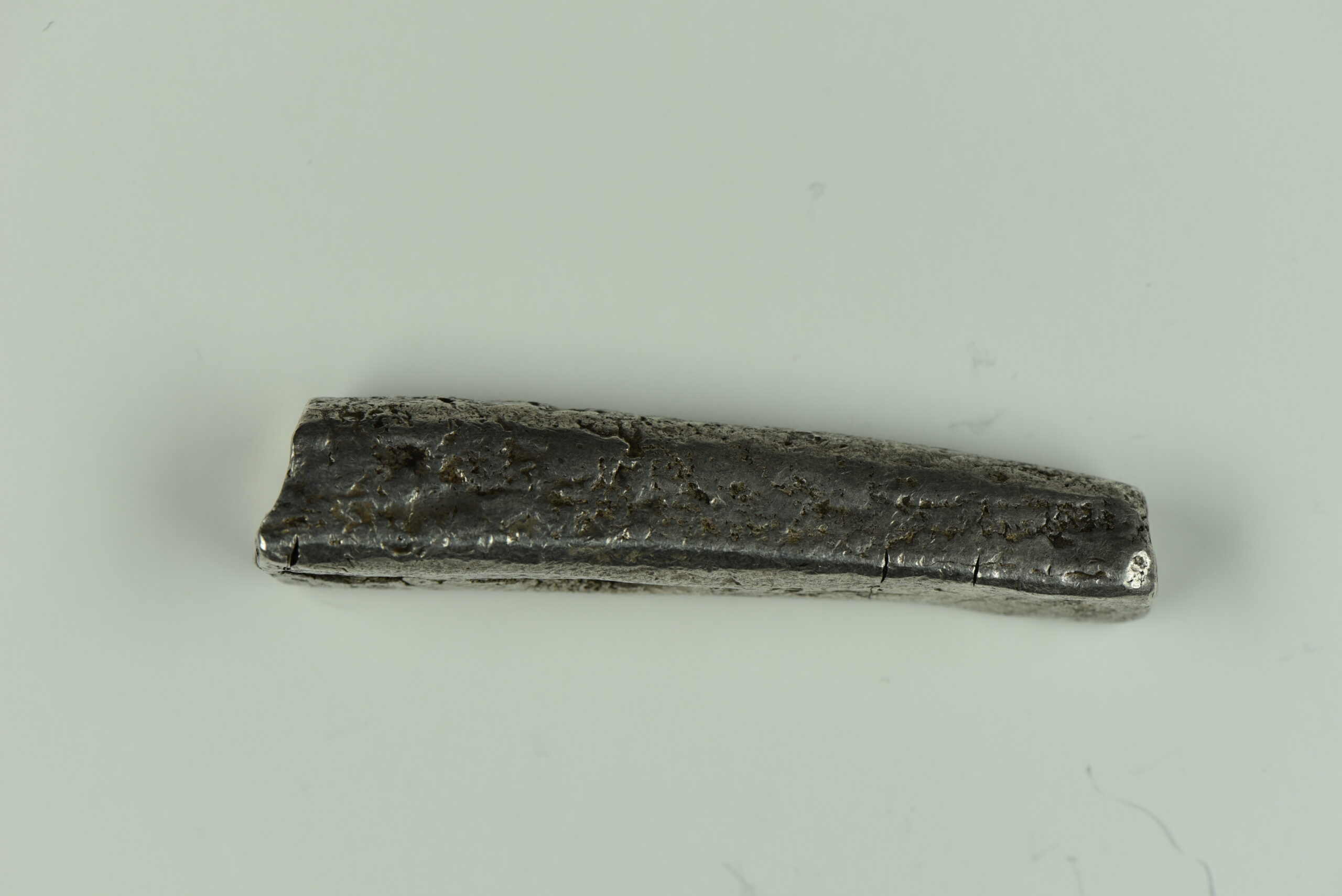
Half-Grivna
The half-grivna of Novgorod (½ grivna) dated back to the turn of the 13th and 14th centuries comes from the territory of former Ruthenia. The grivna is one of the medieval precious metals, in the shape of a bar or a rod, cast from high-purity silver. In the 11th–14th centuries, during the period of Ruthenia’s territorial fragmentation, after the death of Yaroslav the Wise, there were several types of them – the Kiev, the Novgorod, the Chernikhiv, the Lithuanian, and the Volga ones. They differed not only in shape, but also in weight - depending on the different weight systems prevailing in the areas neighboring Ruthenia. Our half-grivna weighs 98.18 g and measures 69.8 by 14.5 by 14.4 mm. On one of the shorter sides there is an evident trace of a break or cut. The grivnas of Ruthenia were chopped into halves or smaller fragments to obtain units of lower value. Hence, from the Ruthenia’s word "rubit" (to chop) came the name of the later Russian ruble, mentioned for the first time in the so-called birch bark letter dated to 1281–1289, i.e. on a written piece of birch bark, found during excavations in Nowogród in 1952.
The exhibit is available in the room:
Antiquity – Middle Ages – Modernity
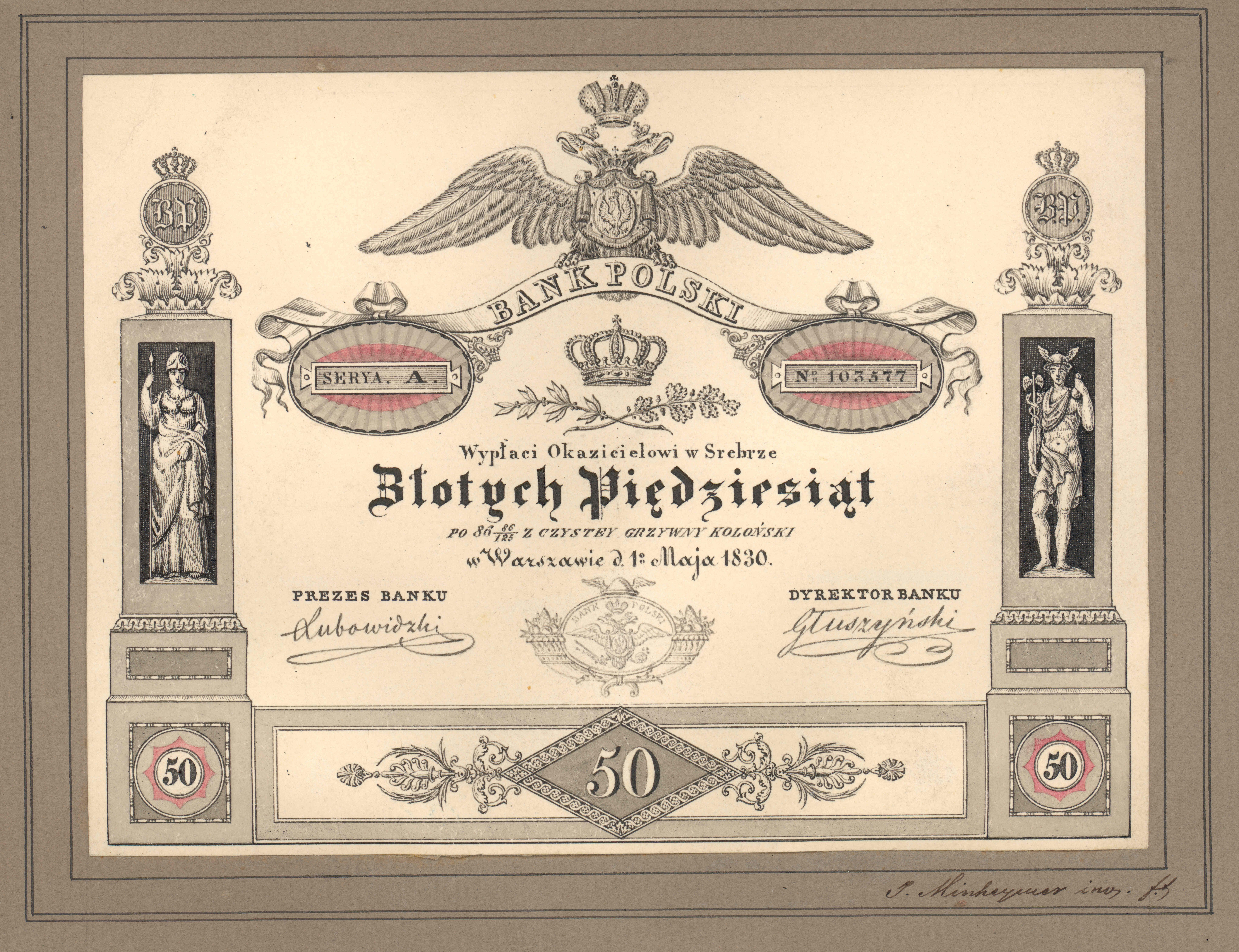
Bank of Poland’s banknote designs (1830-1865)
In the numismatic collection of Narodowy Bank Polski there is a folder decorated with a hand-made drawing of the national emblem of the Kingdom of Poland, depicting a black, two-headed Romanovs imperial eagle with a shield on its chest featuring a crowned white eagle and the inscription "Patterns and Designs of Paper Money of the Bank of Poland from 1830 to 1865". The folder contains 40 hand-made banknote designs and individual banknote elements, as well as a postage stamp design. None of the projects in the folder reached full implementation in the form of a banknote put into circulation. They contained too many national elements. However, minor decorative details, guilloches and even microprinting were used for the first time to secure Polish banknotes.
In the Money Centre, in the Room dedicated to the creators and production of money, there is a showcase that is sometimes overlooked or even unnoticed by visitors. It contains images and fragments of images of the graphic designs of banknotes prepared for the Bank of Poland by Henryk Meyer and Jan Münheymer. This is undoubtedly one of the most interesting showcases, illustrating the development of design techniques and trends prevailing in the design of securities in 19th-century Europe.
The exhibit is available in the room:
Creator of Money and Money Production
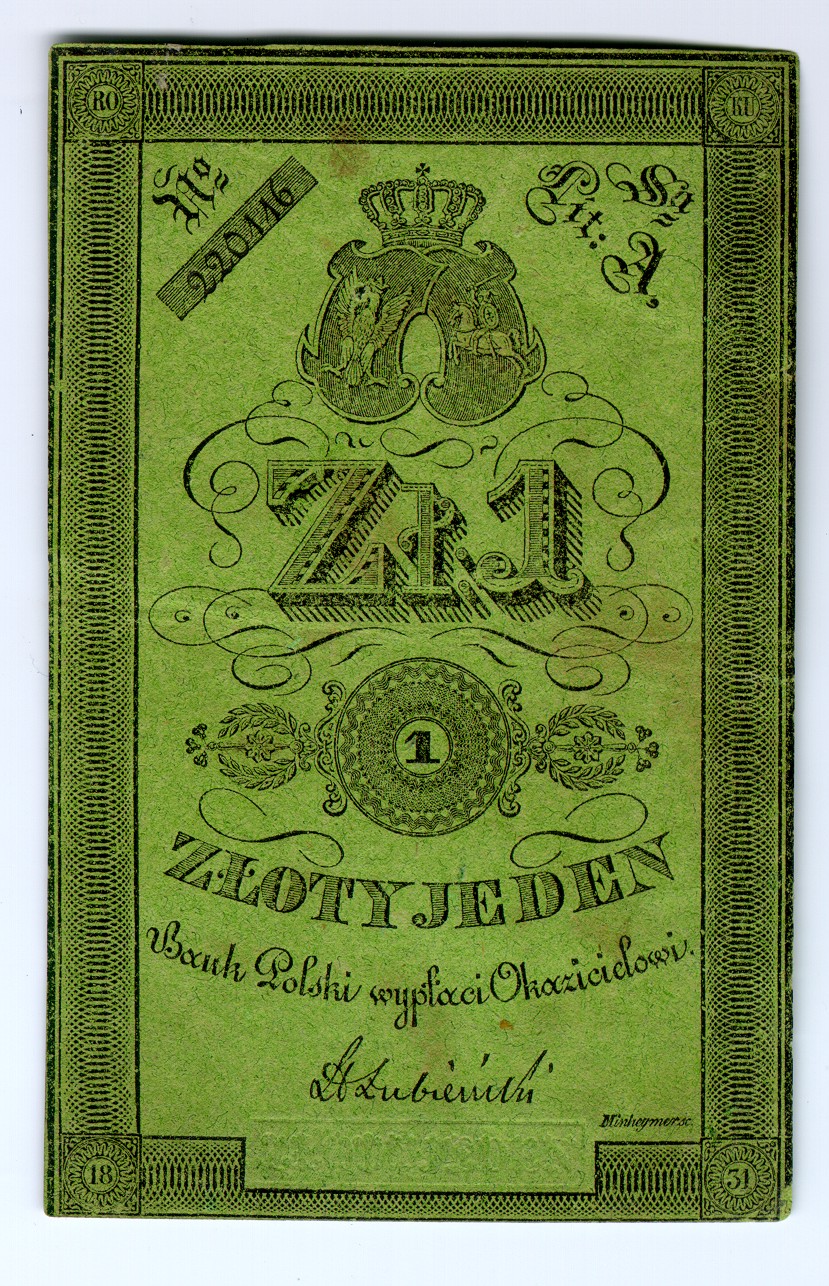
Banknote from the November Uprising
The one-zloty banknotes introduced into the circulation amounted to PLN 735,000. They were made on green-tinted paper, measuring 64 x 103 mm, sourced from the bank paper factory in Jeziorna near Warszawa, secured by a watermark showing the centrally placed digit "1". The graphic design was created by Jan Minheymer, who was an engraver of the Bank Polski. Centrally, at the top, the author placed a cartouche consisting of two stylized heraldic shields with the Polish eagle and the Lithuanian Pahonia, crowned with a closed-type royal crown. On the sides of the cartouche he placed the number on the left and the series of the banknote on the right. Below the heraldic shields, on the background of the lines, there is an inscription: "Zł 1", under which a fancy ornament with the Arabic numeral "1" and the inscription: "zloty one" presented the denomination of the banknote. At the bottom, a centrally placed inscription says: "The Bank of Poland shall pay the Bearer". Below there was a facsimile of one of the bank's directors - Paweł Głuszyński or Henryk Łubieński. In the lower right corner there is the designer's and engraver's signature: "Minheymer sc." The entire image was complemented by a guilloche frame with the inscription and the date in the corners - "RO-KU-18-31". The reverse side was left unprinted. This is the first Polish banknote printed using the lithographic technique. Additional security feature for the banknote is provided by a rectangular dry stamp with the inscription: "Złoty 1" cut into the lower guilloche frame. The banknote was into circulation from August 1, 1831 to June 1, 1832. Many of these banknotes were not returned to the bank and, carefully kept in Polish homes, constituted a national souvenir reminding of the period of armed efforts to restore independence.
The exhibit is available in the room:
Numismatist’s Study
5 ducats
1677, John III Sobieski, commemorative donative minted on the occasion of the restoration of the Kraków mint, designed by Jan Höhn.
Obverse: bust of the king in a cloak, facing right. The head is crowned with a laurel. Inscription around the rim: IOANNES III D[EI]. G[RATIA]. REX POL[ONIAE]. M[AGNUS]. D[UX] LIT[HUANIAE]. RUS[SIAE]. PR[USSIAE] (translation: John III, by the grace of God, King of Poland, Grand Duke of Lithuania, Ruthenia, Prussia).
Reverse: the view of Kraków with defensive walls from the Vistula side. Above, the rays of sun spread from a wreath of clouds. Below the panorama, in cutaway, the date: MDCLXXVII (1677), below the inscription: .APR., preceded by a stylized stamp resembling the combined letters J and H, which may be the initials of Jan Höhn. The letters APR are translated by Edward Raczyński in "The Cabinet of Polish Medals" as Aprilis (April). At the bottom, a semicircular inscription: ALMA URBS CRACOVIA (translated as: the famous city of Kraków).
These coins were minted in denominations weighing three, four and five ducats. The most common are three-ducat coins. The presented five-ducat donative is one of the few coins minted in this denomination.
The exhibit is available in the room:
Numismatist’s Study
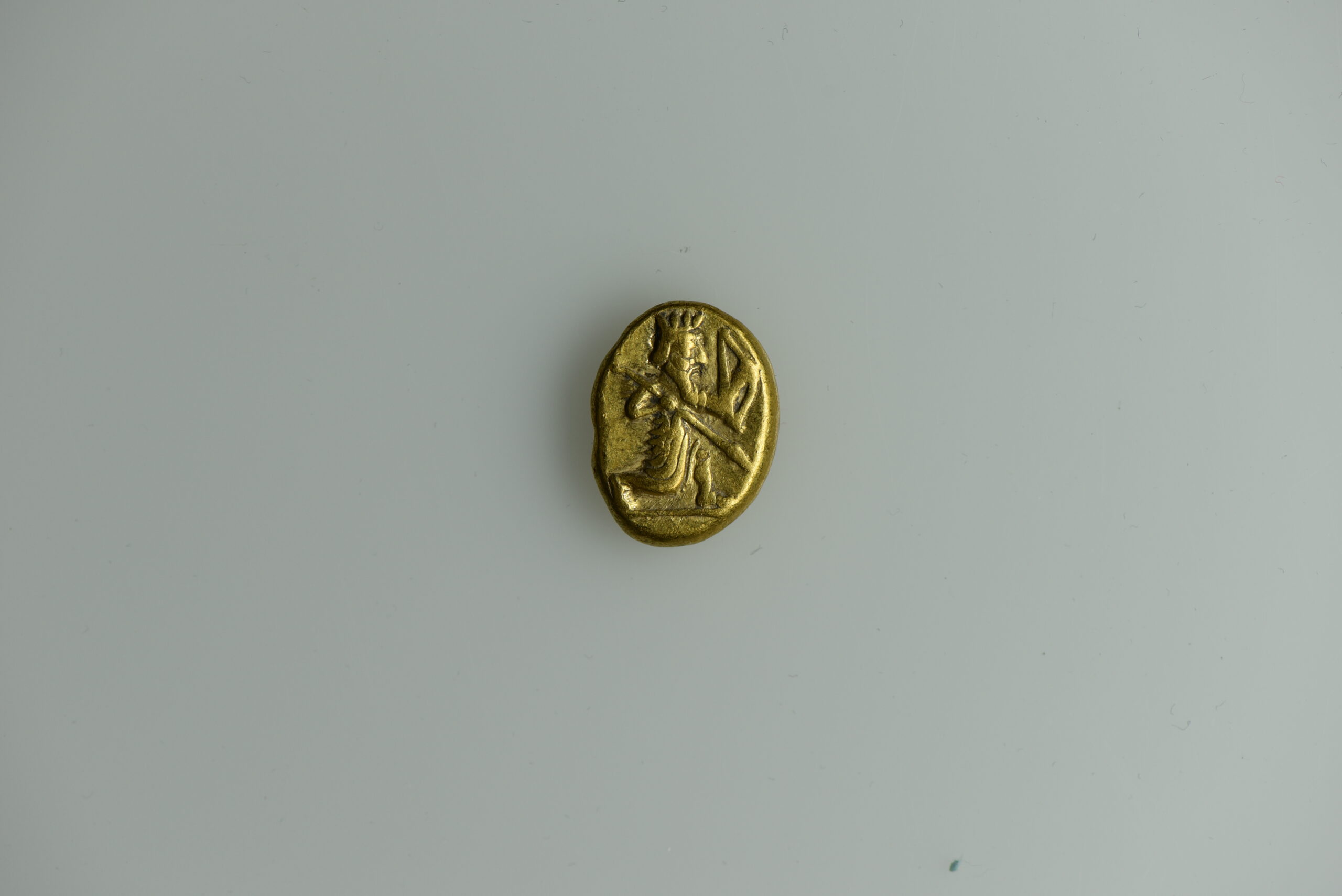
Daric
A gold coin from ancient Persia, dated back to the 5th century BC. Its name comes from the name of the famous Persian king Darius I the Great from the Achaemenid dynasty, who was the first to mint such gold staters (coin denominations). Some, however, derive it from the Old Persian dari - meaning gold. The obverse shows the figure of an archer running to the right in ceremonial Persian robes and a traditional headdress, sometimes called a crenellated crown. It is a symbolic, conventional and stylized image of the Great King or King of Kings - both of these titles traditionally belonged to the Persian ruler. In this case, however, it cannot be certain that it was Darius, because numismatists date this type of daric, on which the ruler is equipped with a bow and a spear (so-called type III), to around 485 BC, i.e. the end of the reign of Darius the Great and the beginning of the reign of his son and successor - Xerxes I.
The reverse of the coin is a so-called quadratum incusum (recessed square) in its simplest and oldest form. The irregular shape reflects the lower punch on which the lump was placed before being struck by the upper punch. The surface of the lower punch was intentionally uneven to prevent the lump from shifting in a way that made it impossible to nail the obverse punch. Despite the fact that at that time, on the coins of the Anatolian Greeks neighboring Persia, the recessed square already had the regular form of a windmill wing, a swastika or even a specific image, the Persians retained its archaic irregular shape until the end of the issuance of darics.
The exhibit is available in the room:
Antiquity – Middle Ages – Modernity
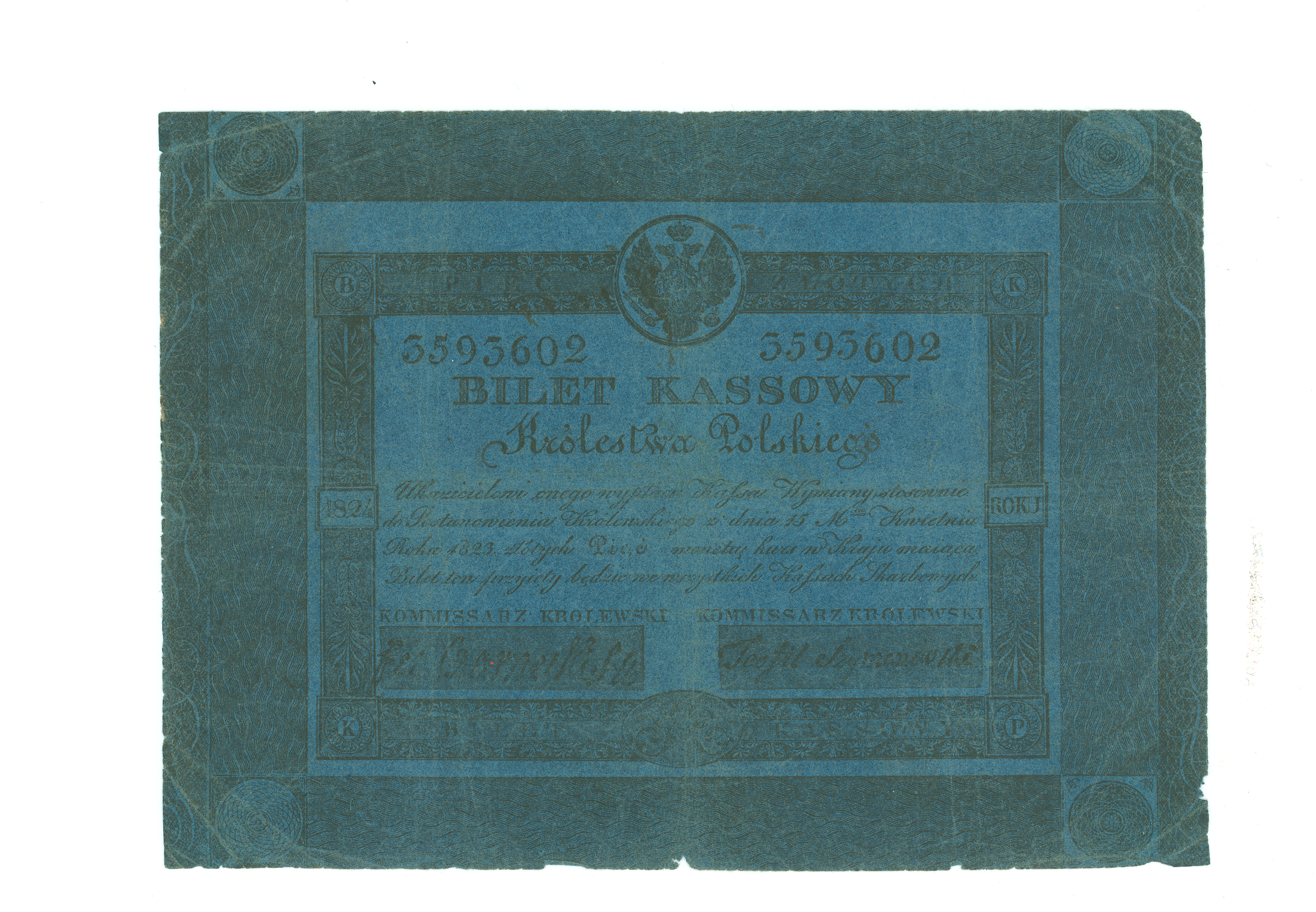
Cash banknotes
Cash banknotes were introduced for circulation by the Bank of Poland in 1828. They were printed in 1824 on thin paper in four categories corresponding to their denominations. In category A. there were blue banknotes with a value of PLN 5, in category B. there were red ones with a value of PLN 10, in category C. white banknotes with a value of PLN 50, and in class D. also white ones with a value of PLN 100. These banknotes were printed using the copperplate engraving technique. They were the first Polish banknotes printed on both sides. Few of them have survived to the present day, and all those that are left are very rare today.
The exhibit is available in the room:
Central Bank
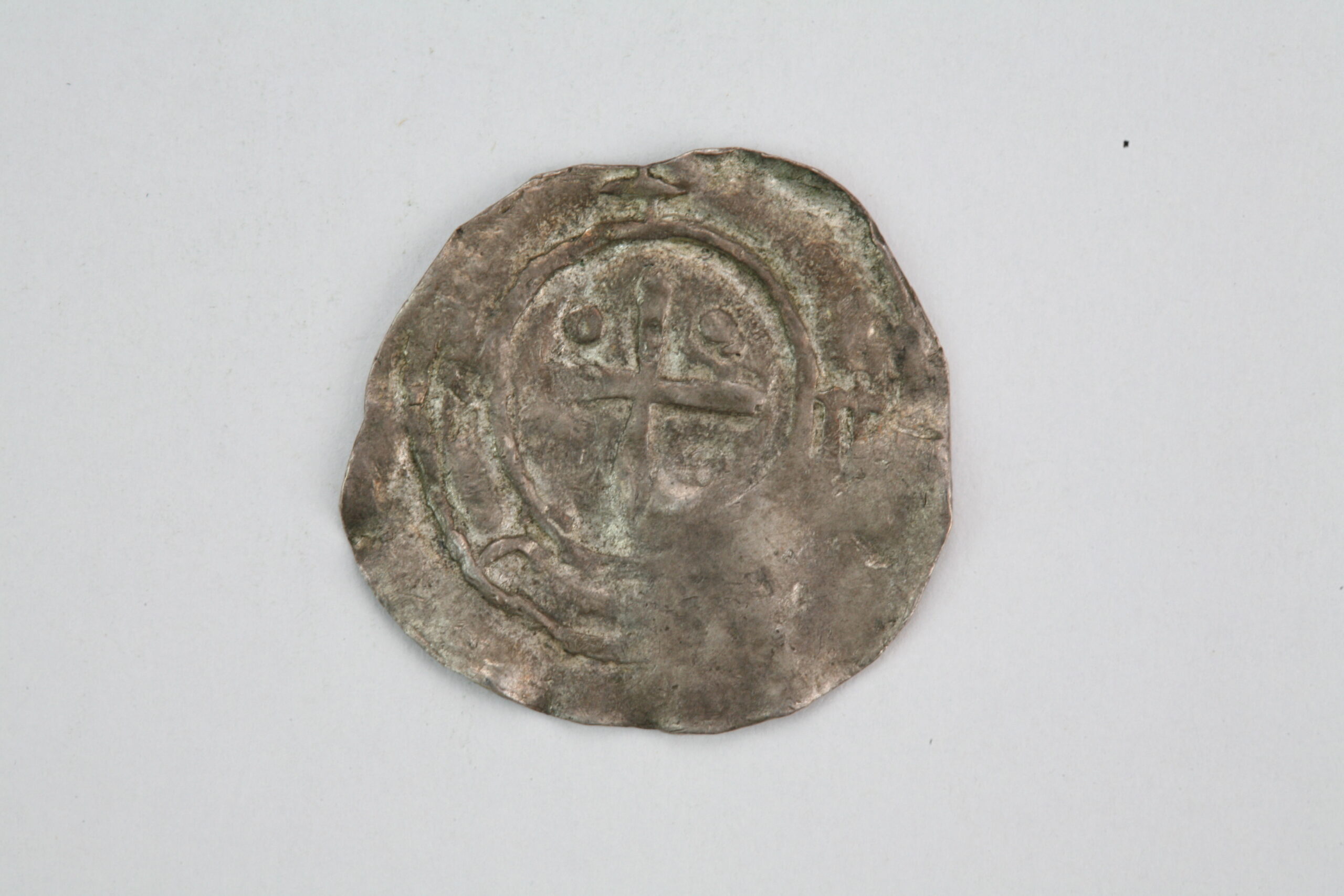
Denarius of Mieszko II
In a showcase with the oldest Polish coins there is an interesting denarius. There is an ongoing dispute among medieval researchers about this seemingly unattractive coin. The denarius was once considered the oldest Polish coin, minted by the first ruler of the Polish country, Mieszko I (approx. 960–992). However, currently most researchers, including the author of the earlier concept, attribute this coin rather to the grandson of Mieszko I, who incidentally bears his name, i.e. the future king Mieszko II Lambert (1025–1034). With the discovery of new treasures of early medieval money and changes in attributions (i.e. determining the place and the date of minting the coin and the issuer) of other coins, some indications emerged suggesting that the coin could have been minted during the reign of Bolesław the Brave (992–1025) by Mieszko Bolesławowic as prince and heir to the throne. As if the situation was not already complicated, some numismatists still opt for earlier attribution, referring to the general appearance of the denarius, its iconography and average weight. The denarius from the NBP collection belongs to the older type according to the prof. Stanisław Suchodolski’s classification. And there would be nothing unusual about this coin if it were not for the fact that on both sides, especially on the obverse, there are some additional elements that are not found on any other of the approximately 40 known specimens.
The exhibit is available in the room:
Numismatist’s Study
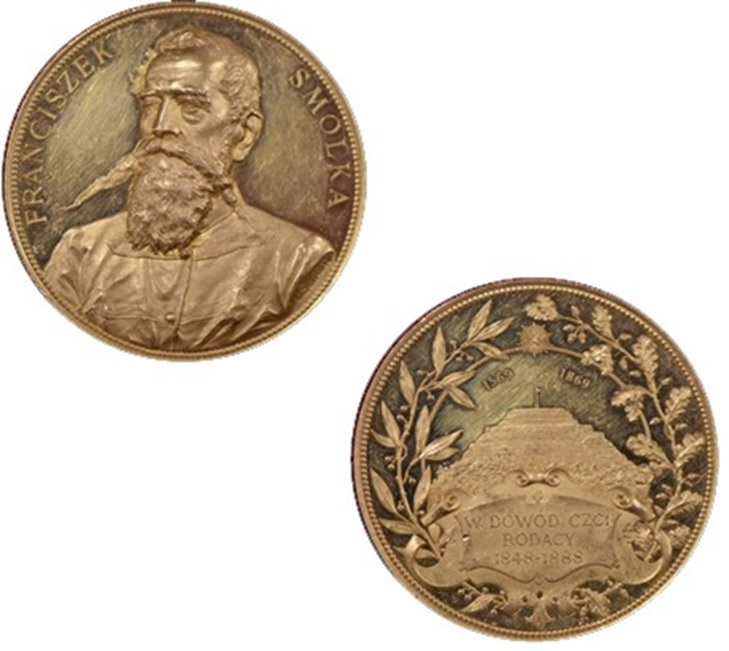
Medals
The medals that can be admired at the Money Centre are a real treat for numismatists and researchers of the history of Poland. Made to commemorate important events and prominent figures across different domains, minted as decorations or awards for outstanding achievements, they are a testimony of times gone by. Among the collected medals, we can admire the one minted in honor of the 40th anniversary of Franciszek Smolka's presidency in the of the Galician Diet (Sejm Krajowy) and his chairmanship of the committee for the construction of a mound commemorating the 300th anniversary of the Union of Lublin. Only one copy of this medal was minted in gold!
In 1454, the outbreak of the anti-Teutonic uprising in Gdańsk led to the annexation of that city to the Kingdom of Poland by Casimir IV Jagiellon, and after the end of the Thirteen Years' War - the entire Royal Prussia. The commemoration of these events is reflected in two medals that are 100 years apart. The first of them was minted in 1654 during the reign of John II Casimir. The second one was minted by an unknown author, on the request of the Senate of Gdańsk in 1754, during the reign of Augustus III the Saxon.
The exhibit is available in the room:
Numismatist’s Study
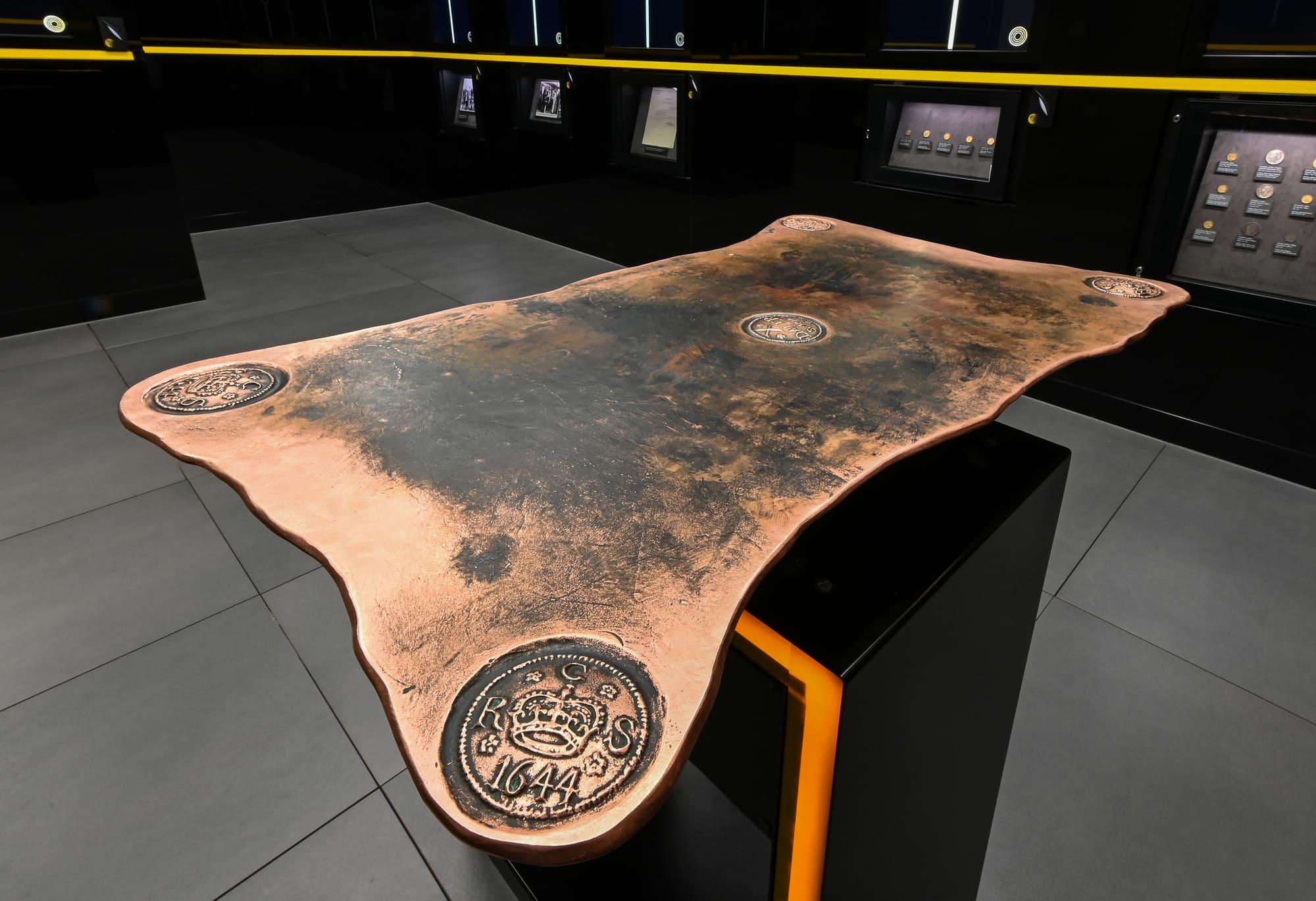
Platmynt
A replica of a 17th-century copper coin weighing 19.7 kg and worth 10 riksdalers (equivalent to 10 thalers). Platmynts were large in size because their value had to correspond to dallers minted in silver. The functioning of platmynts is related to the issuance of paper money. In 1661, the private bank, Stockholms Banco was established. Holders of platmynts had the opportunity of depositing them and in return receiving paper bearer certificates that could be used to settle transactions. This eliminated the need to use bulky copper coins in everyday business.
Exhibit available in the room:
Monetary Systems
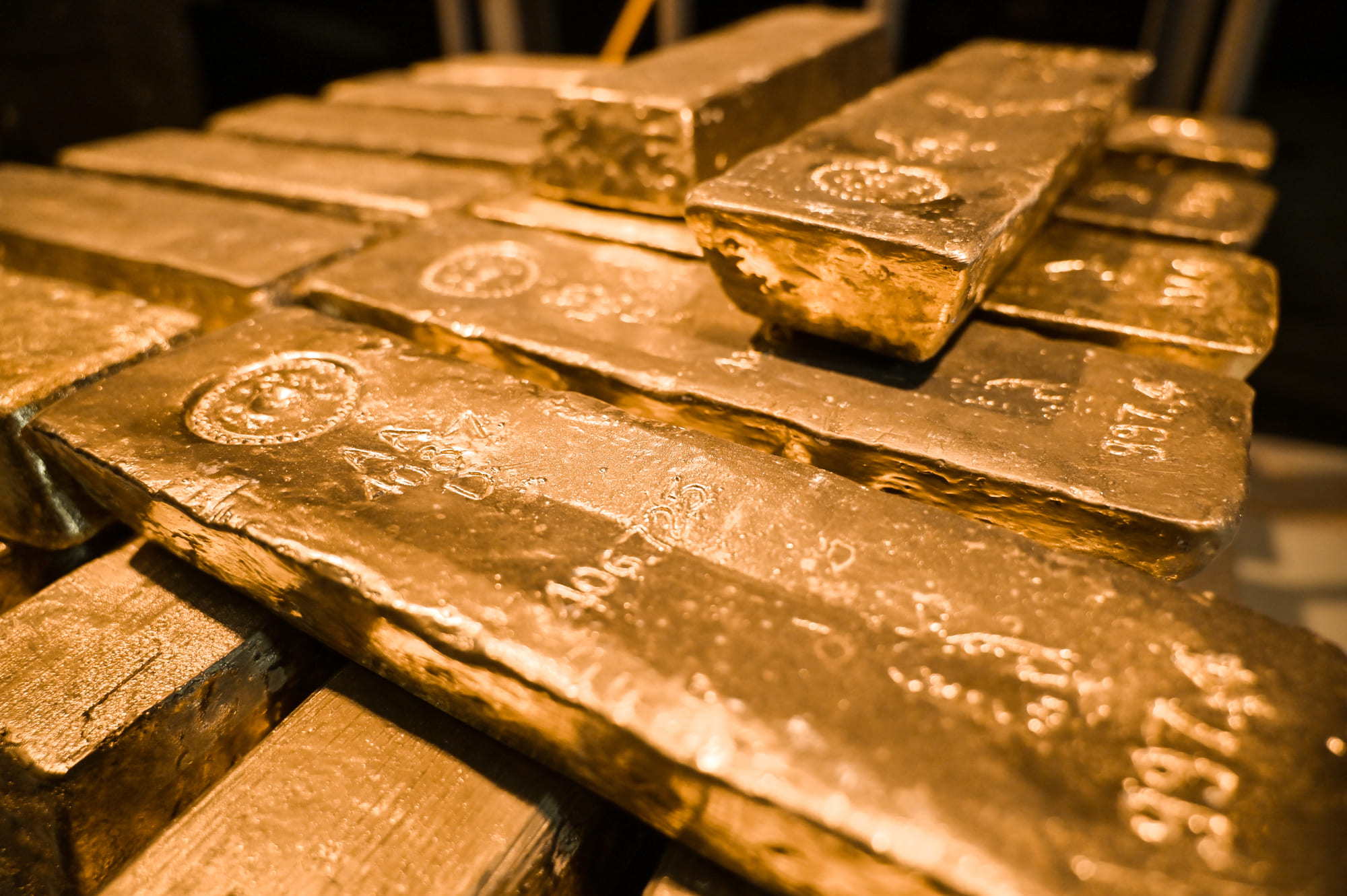
Gold bar
The gold bar is placed in a dedicated showcase with a cutout allowing visitors to hold it in their hand or lift it. The bars used for storing gold reserves by banks are standardized. This particular one weighs 400 troy ounces (the so-called Good Delivery standard). One troy ounce is approximately 31.1 grams. Therefore, the total weight of the bar in kilograms is approximately 12.5 kg. Its value is variable and depends on the current price of an ounce of gold listed on international markets and the US dollar exchange rate, but it usually fluctuates around PLN 3 million.
The exhibit is available in the room:
Vault
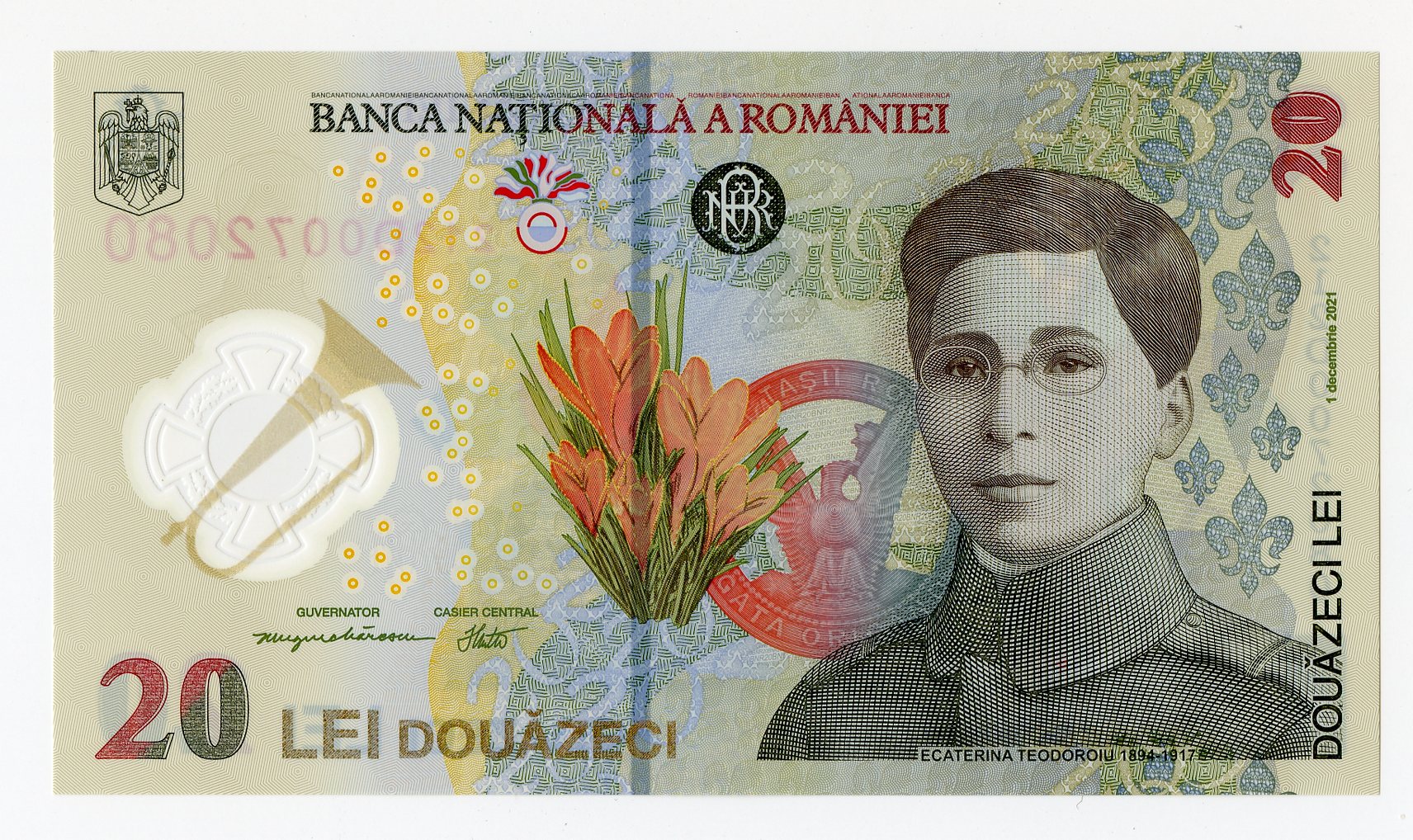
Romanian polymer banknote of 20 leu
The polymer 20 leu commemorates Ecaterina Teodoroiu - a lieutenant in the Romanian army during World War I, and the first female lieutenant in the history of the Romanian army. The idea of depicting women on Romanian currency arose in 2018, when fashion journalist Janina Nectara created a list of 100 female figures, including Teodoroiu, scientists, doctors, artists and professors worth commemorating.
The dimensions of the banknote are 136x77 mm. The obverse shows: portrait of Ecaterina Teodoroiu (1894-1917), a bouquet of crocuses, a badge of Romanian Scouts, a stylized image of an infantry insygnia and the name of the issuer. The reverse shows, among others: the Mausoleum of Mărăşeşti, winged figure of the goddess of victory from the Victory Medal and the flower of lily.
The exhibit is available in the room:
Laboratory of Authenticity
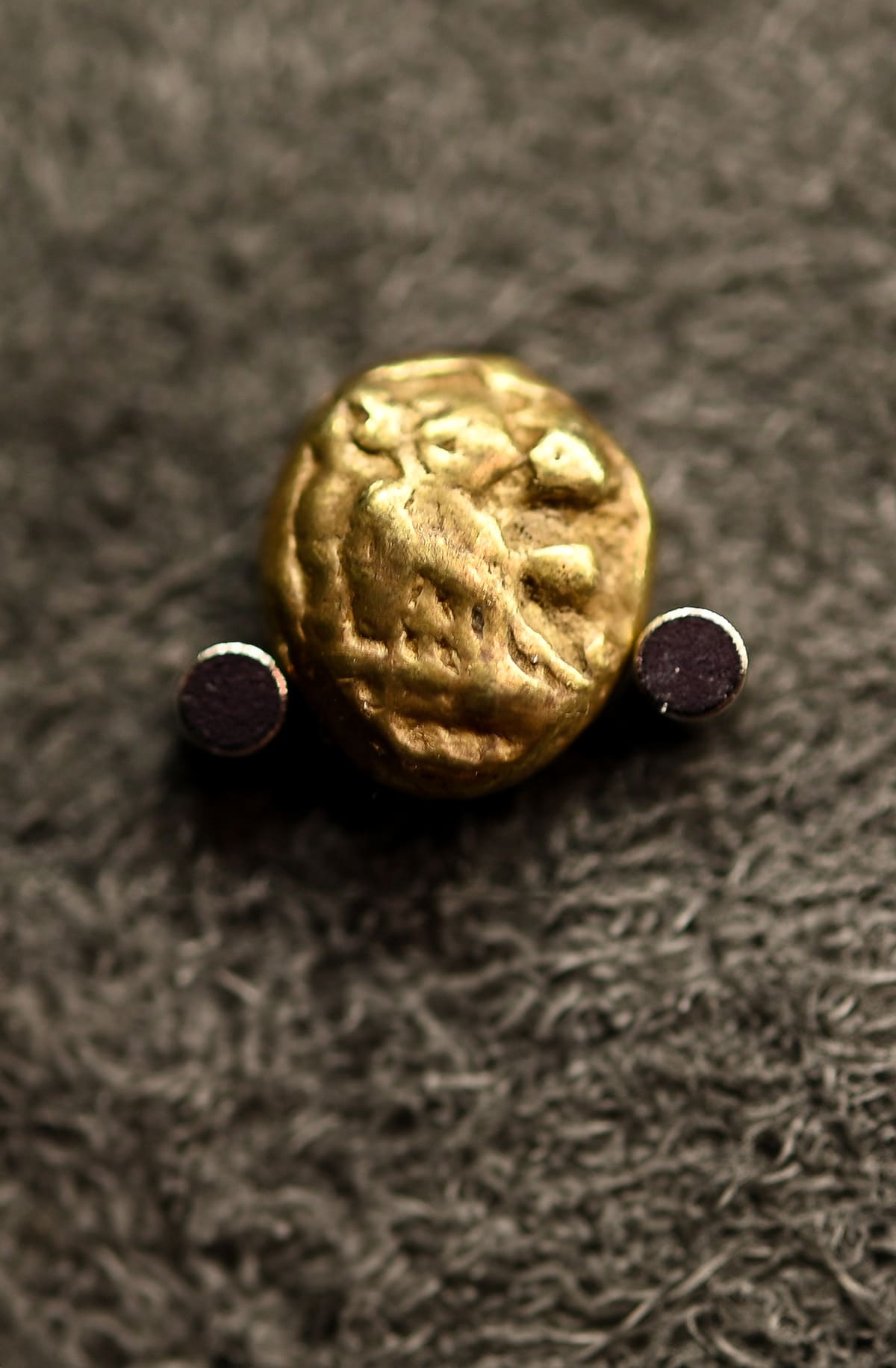
Hemihekte
A small lump of ore known as Electrum, a natural alloy of gold and silver, is one of the smallest exhibits presented in the Money Centre. Due to the symbol impressed on this item, it is considered to be one of the first coins in the world. The emergence of this coin is dated back to the middle of the 7th century BC. It is believed to have been put into circulation by one of the Lydian kings of the Mermnad dynasty. The first Lydian electron coins were minted on one side. On their obverse, i.e. the main side of the coin, there was a symbol of power - the head of the Lydian lion. The electron coin at the MC exhibition is a hemihekta (1/12 stater) weighing 1.15 grams. This valuable item is kept in a safe showcase.
The exhibit is available in the room:
Antiquity – Middle Ages – Modernity







